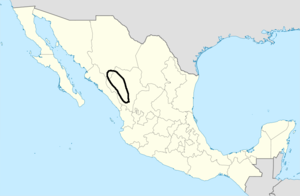- Tepehuán people
-
Tepehuán Total population Mexico: approx 25,000 Regions with significant populations Mexico (Jalisco, Zacatecas, Nayarit) Languages Religion Related ethnic groups Cora, Huichol
The Tepehuán (Tepehuanes or Tepehuanos, from Nahuatl “People from the Mountains”) are a Native American ethnic group in northwest Mexico, whose villages at the time of Spanish conquest spanned a large territory along the Sierra Madre Occidental from Chihuahua and Durango in the north to Jalisco in the south. The southern Tepehuán community included an isolated settlement (Azqueltán) in the middle of Huichol territory in the Bolaños River canyon. The southern Tepehuán were historically referred to as Tepecanos. See Also: Tepehuán Revolt
The Tepehuán languages are part of the Uto-Aztecan language family, within which it is grouped with O'odham to form the Piman family.
The name is pronounced [tepeˈwan] in Spanish, and is often spelled Tepehuan without the accent in English-language publications. This can cause confusion with the languages called Tepehua ([teˈpewa] in Spanish) and collectively referred to as Tepehuan in English. These are spoken on the other side of Mexico, and are closely related to Totonac and not at all to Tepehuán. The names of both groups come from Nahuatl and mean 'mountain dwellers' or 'mountain people'.[1]
The Tepehuán Revolt from 1616 to 1620 was a bloody and ultimately futile attempt by the Tepehuán, inspired by a messianic leader named Quautlatas, to rid their territory of the Spanish.
Tepehuán groups
Three groups of Tepehuán survive:
Northern Tepehuán (Odami - “People”, lived and live north of the Rio Verde in Chihuahua and in northern Durango and Sinaloa)
- Baborigame (about 6.200 speaker, some use a dialect variant similar to the Tarahumara)
- Nabogame (about 1.800 speaker)
Southern Tepehuán (Dami - “People”, lived in the Sierra Madre Occidental in southern Durango and northern Nayarit and Jalisco)
- Southeastern Tepehuán (about 10.600 speaker, lived in southeast Durango and adjacent areas, their cultural and religious center was Santa Maria Ocotán)
- Southwestern Tepehuán (about 8.700 speaker, lived in southwest Durango and adjacent areas)
They still retain some of their old customs.[2] The northern Tepehuán numbered 6,200 in 2005; the southeastern, 10,600, and the southwestern, 8,700.[3]
References
- ^ Tepehuán Language and the Tepehuan Indian Tribe (Tepecano, Tepehuano)
- ^ Gradie, 17-183
- ^ http://www.native-languages.org/tepehuan.htm, accessed Feb 13, 2011
External links
Categories:- Ethnic groups in Mexico
- Indigenous peoples in Mexico
- Native American tribes
- Sierra Madre Occidental
Wikimedia Foundation. 2010.

